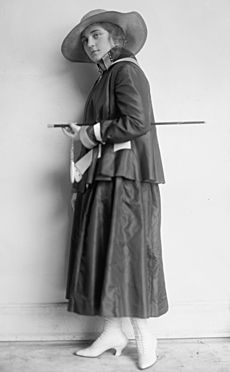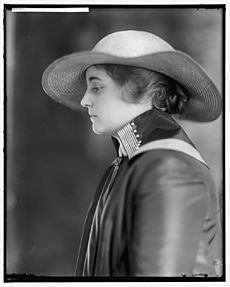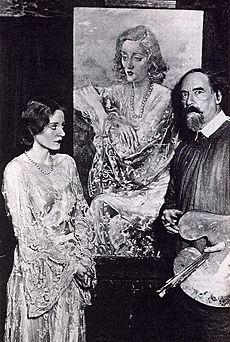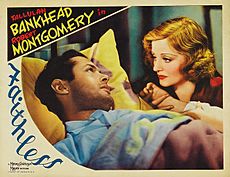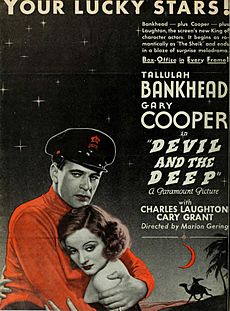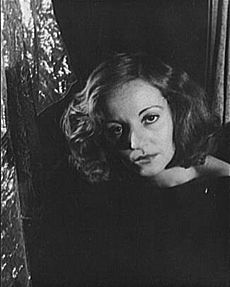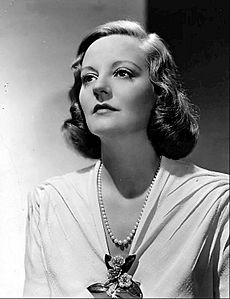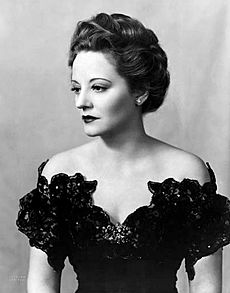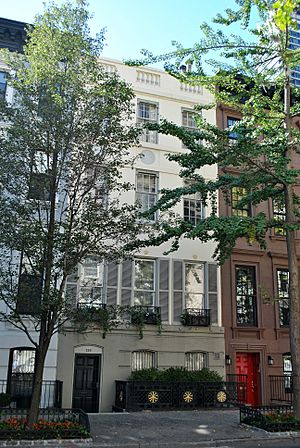Tallulah Bankhead facts for kids
Quick facts for kids
Tallulah Bankhead
|
|
|---|---|
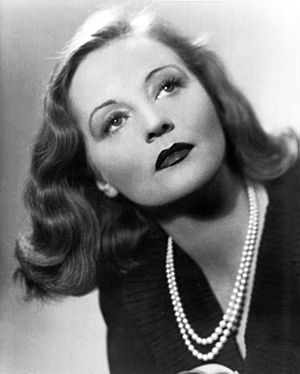
Bankhead in 1941
|
|
| Born |
Tallulah Brockman Bankhead
January 31, 1902 Huntsville, Alabama, U.S.
|
| Died | December 12, 1968 (aged 66) New York City, New York, U.S.
|
| Resting place | Saint Paul's Churchyard Kent County, Maryland, U.S. |
| Occupation | Actress |
| Years active | 1918–1968 |
| Spouse(s) |
John Emery
(m. 1937; div. 1941) |
| Parent(s) |
|
| Relatives |
|
Tallulah Brockman Bankhead (born January 31, 1902 – died December 12, 1968) was a famous American actress. She was mostly known for her work on stage, but she also appeared in important movies like Alfred Hitchcock's Lifeboat (1944), where she won an award for her acting. Tallulah also had a successful career on radio and appeared on television. Throughout her career, she took on nearly 300 roles in films, on stage, and on TV and radio. She was honored by being added to the American Theater Hall of Fame in 1972 and the Alabama Women's Hall of Fame in 1981.
Contents
Tallulah Bankhead's Early Life
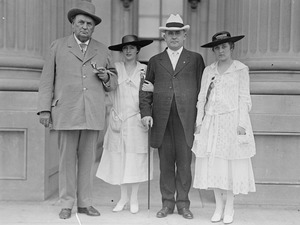

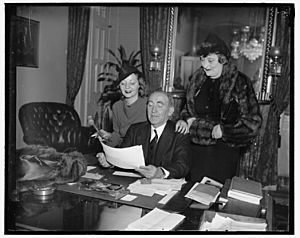
Tallulah Brockman Bankhead was born on January 31, 1902, in Huntsville, Alabama. Her father, William B. Bankhead, came from a well-known political family in Alabama. He later became the Speaker of the United States House of Representatives from 1936 to 1940. Her mother, Adelaide Eugenia "Ada" Bankhead, died shortly after Tallulah was born, when Tallulah was only three weeks old.
Because her father was very sad after her mother's death, Tallulah and her older sister, Eugenia, were mostly raised by their grandmother at the family home called "Sunset" in Jasper, Alabama. As a child, Tallulah was very active and loved to get attention. She taught herself to do cartwheels and would often sing and recite poems she had memorized. She also had a strong, husky voice, which she said was "mezzo-basso" (a deep singing voice). This voice was due to a childhood illness.
Tallulah quickly learned that performing helped her get the attention she wanted. She was good at copying people and would entertain her classmates by imitating their teachers. She even claimed that her "first performance" was for the famous Wright brothers, Orville and Wilbur, where she won a prize for imitating her kindergarten teacher. Tallulah also had an amazing memory for literature.
When Tallulah was 10 and Eugenia was 11, they were sent to a convent school in New York. As their father's political career grew, they moved to different schools closer to Washington, D.C. When Tallulah was 15, her aunt encouraged her to take more care of her appearance. Tallulah became a "southern belle," a term for a charming young woman from the American South. Tallulah was also friends with Zelda Sayre Fitzgerald, who later became a novelist and the wife of writer F. Scott Fitzgerald.
Tallulah Bankhead's Acting Career
Starting Out in New York (1917–1922)
At 15, Tallulah entered a contest in Picture Play magazine. She won a trip to New York and a small movie role. She quickly found her place in New York City, moving into the Algonquin Hotel, a popular spot for artists and writers. There, she became friends with famous people and was known as one of the "Four Riders of the Algonquin." She also met actress Ethel Barrymore, who suggested she change her name, but Tallulah refused. Later, Vanity Fair magazine wrote that she was "the only actress on both sides of the Atlantic to be recognized by her first name only."
After a few small silent film roles, Tallulah made her first stage appearance in The Squab Farm in New York in 1919. She soon realized she preferred acting on stage to acting in movies. She appeared in several plays, but they were not very successful. After five years in New York without a big hit, Tallulah decided to move to London.
Becoming Famous in Great Britain (1922–1931)
In 1923, Tallulah made her London stage debut. Over the next eight years, she appeared in more than a dozen plays in London. Her fame grew in 1924 when she played Amy in They Knew What They Wanted, a play that won a major award.
While in London, Tallulah bought a Bentley car, which she loved to drive. She often got lost, so she would call a taxi and pay the driver to lead the way while she followed in her car. During her time in London, Tallulah became known for making even weak plays exciting. She once described a funny moment during a play called Conchita: a monkey she was carrying grabbed her wig, ran to the front of the stage, and waved it at the audience! Tallulah responded by doing a cartwheel, which made the audience roar with laughter.
Hollywood Career (1931–1933)
Tallulah returned to the United States in 1931. Her first few Hollywood films were not very successful. She found filmmaking boring because it required a lot of waiting. However, the chance to earn $50,000 per film was too good to miss. In 1932, she starred in Devil and the Deep with famous actors Gary Cooper, Charles Laughton, and Cary Grant.
Returning to Broadway (1933–1938)
Back on Broadway, Tallulah acted in several plays that later became successful Hollywood movies starring other actresses. For example, her play Dark Victory was later made into a famous film starring Bette Davis.
Tallulah continued to perform on Broadway. She received great reviews for her role as Elizabeth in The Circle. However, when she appeared in Shakespeare's Antony and Cleopatra with her husband, John Emery, a critic famously wrote that she "barged down the Nile last night as Cleopatra – and sank."
From 1936 to 1938, the producer of Gone with the Wind, David O. Selznick, considered Tallulah for the role of Scarlett O'Hara. Her screen test was excellent, but she didn't look as good in Technicolor film. Selznick also thought she was too old at 36 to play the 16-year-old Scarlett. The role eventually went to Vivien Leigh.
Critical Success (1939–1945)
Regina and Sabina
Tallulah's amazing performance as Regina Giddens in The Little Foxes (1939) earned her Variety magazine's award for Best Actress of the Year. Her portrayal of Regina was called "one of the most electrifying performances in American theater history." During the play's run, she was featured on the cover of Life magazine. Tallulah called Regina "the best role I ever had in the theater."
She won another Variety award and the New York Drama Critics' Award for her role as Sabina in Thornton Wilder's The Skin of Our Teeth. A newspaper wrote that her acting had both comedy and passion, and it was a mystery how she managed both at the same time.
Lifeboat
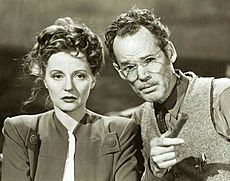
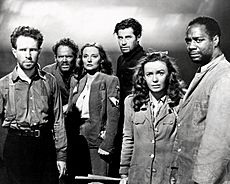
In 1944, Alfred Hitchcock cast Tallulah as a journalist named Constance Porter in her most successful film, Lifeboat. Her excellent performance was considered her best in a movie and won her the New York Film Critics Circle award. When she accepted her award, a happy Tallulah exclaimed, "Dahlings, I was wonderful!"
Continued Success (1948–1952)
Tallulah appeared in a new production of Noël Coward's Private Lives, which she toured with and then brought to Broadway for almost two years. This play made her a lot of money. From then on, Tallulah could earn 10% of the play's total earnings.
In 1950, NBC radio hired Tallulah to host The Big Show. She was the main host and performed monologues (often written by Dorothy Parker) and songs. Even with famous guest stars, the show didn't beat the ratings of other popular radio programs.
Later Career (1952–1968)
Tallulah wrote a bestselling book about her life called Tallulah: My Autobiography, published in 1952. Although her career slowed down in the mid-1950s, she remained famous. She continued to perform on Broadway, radio, television, and in occasional films until her death in 1968.
In 1953, Tallulah performed a stage act at the Sands Hotel in Las Vegas. She was paid a lot of money each week to recite scenes from plays, read poetry, and sing. Critics thought she might fail, but she was a huge success and returned to the Sands for three years.
Last Years on Stage
In 1956, Tallulah played Blanche DuBois in a new production of Tennessee Williams' A Streetcar Named Desire. Williams had wanted her for the original play, but she had turned it down. Although her first performances were criticized, she worked hard to improve. Williams later said he cried during one of her performances and rushed to her feet afterward, praising her acting. However, the play closed after only 15 performances.
Tallulah was nominated for a Tony Award for her role in the play Midgie Purvis (1961). It was a physically demanding role, and she insisted on doing her own stunts, like sliding down a staircase railing. She received great reviews, but the play didn't last long. Her last stage appearance was in The Milk Train Doesn't Stop Here Anymore (1963).
New Media Appearances
Her last movie was a British horror film called Fanatic (1965), which was released in the U.S. as Die! Die! My Darling!. She was paid $50,000 for this role. Her last television appearances were in March 1967 as the villain Black Widow in the Batman TV series, and in a skit on The Smothers Brothers Comedy Hour in December 1967. She also appeared on NBC's The Tonight Show in May 1968, where she interviewed Paul McCartney and John Lennon of The Beatles.
Tallulah Bankhead's Personal Life
Tallulah Bankhead was known not only for her acting but also for her strong personality and witty sayings. She was very outgoing and spoke her mind. She once said, "There is less to this than meets the eye." She lived for the moment.
Tallulah was a big fan of baseball, and her favorite team was the New York Giants. She famously said, "There have been only two geniuses in the world, Willie Mays and Willie Shakespeare. But, darling, I think you'd better put Shakespeare first."
Marriage
Tallulah Bankhead married actor John Emery on August 31, 1937. They divorced in June 1941. The day her divorce was finalized, Tallulah told a reporter, "You can definitely quote me as saying there will be no plans for a remarriage."
Tallulah did not have any children of her own. She was the godmother to the children of her lifelong friend, actress Eugenia Rawls.
Tallulah Bankhead's Death
Tallulah Bankhead died at St. Luke's Hospital in Manhattan on December 12, 1968, at the age of 66. The cause of death was a severe lung infection called pleural double pneumonia.
A private funeral was held on December 14, 1968, at St. Paul's Episcopal Church in Chestertown, Maryland, where she was buried. A memorial service was also held for her in New York City on December 16, 1968.
Tallulah Bankhead's Legacy
Tallulah Bankhead is remembered as one of the greatest stage actresses of the 20th century. She was praised for her natural talent and energy in both serious and funny roles. For over 20 years, she was one of the most celebrated actresses in Broadway and London. Critics often called her a rare and unique talent. At the peak of her career, she was considered a "living legend" and Broadway's most original leading lady. Her unique personality helped her career.
Decades after her death, people continue to be interested in Tallulah Bankhead, leading to a new appreciation for her work.
Awards and Honors
Tallulah Bankhead received many awards for her acting.
- She won a New York Drama Critics Award for Best Performance by an actress in The Skin of Our Teeth in 1942.
- She also won Variety awards for her roles in The Little Foxes and The Skin of Our Teeth.
- She was nominated for a Tony Award for her performance in Midgie Purvis.
- She won the New York Film Critics Award for Best Actress in a Film for her work in Lifeboat.
- Tallulah Bankhead was the first white woman to be featured on the cover of Ebony magazine.
- She was one of the few actresses to have a cover on both Time and Life magazines.
- In 1928, she was named one of the 10 most remarkable women in London.
- A resolution honoring her achievements was passed in the Alabama Legislature.
- For her contributions to the film industry, Tallulah Bankhead has a star on the Hollywood Walk of Fame at 6141 Hollywood Blvd.
- She was one of the first people inducted into the American Theater Hall of Fame when it was created in 1972.
Tallulah Bankhead in Theatre
Tallulah Bankhead was most famous for two roles she created: Regina in Lillian Hellman's The Little Foxes and Sabina in Thornton Wilder's The Skin of Our Teeth. She became good friends with playwright Tennessee Williams, who was very impressed by her. Williams wrote four female roles specifically for her. A song in the 1937 musical I'd Rather Be Right even mentions her. The Bankhead Theater in Livermore Performing Arts Center is named after her.
Tallulah Bankhead in Art
The United Kingdom's National Portrait Gallery has a collection of 50 portraits of Tallulah Bankhead from her years in London. Famous artists like Augustus John and Frank Dobson painted and sculpted her. The Library of Congress also has many works related to Tallulah Bankhead.
Images for kids
-
Tallulah Bankhead at 15 (second from left), with her grandfather John H. Bankhead (far left), father William B. Bankhead (second from right), and older sister Eugenia Bankhead (far right) around 1917
-
"Sunset", the Bankhead family home in Jasper, Alabama, where Tallulah and her sister grew up
-
Speaker of the House William B. Bankhead welcomes his famous daughter to his office in 1937
-
Welsh artist Augustus John with Bankhead and her portrait (1929)
-
Alfred Hitchcock's Lifeboat (1944) with Henry Hull
-
Hitchcock's Lifeboat (1944) with Hume Cronyn, Henry Hull, Bankhead, John Hodiak, Mary Anderson and Canada Lee
See also
 In Spanish: Tallulah Bankhead para niños
In Spanish: Tallulah Bankhead para niños


